| Vintage Pulp | Aug 17 2023 |


Above you see a cover for Peter Rabe's 1955 thriller Benny Muscles In. Rabe had previously debuted with Stop This Man! and would go on to write thirty novels, but he's still green here, and it shows. In the story, Benny Tapkow, a collector for the mob, decides to kidnap his boss's daughter Pat for a rival mobster. Everything goes ridiculously wrong, starting with the rival's henchmen making off with the wrong woman, and continuing with Pat getting hooked on heroin. Overall the book felt like Rabe, early in his authorial career, didn't know quite where to go with these ideas. There's plenty of grit, but not enough precision. We did like the bit, though, where Benny got all quantum: [She] isn't dead. And she isn't alive. She's right between, and the more Pendleton stalls, the worse it'll be for her. Well, maybe that isn't exactly quantum, but it's close, if unintentional. But Rabe would make legit quantum leaps with later works. The art on this Gold Medal edition is by Lu Kimmel.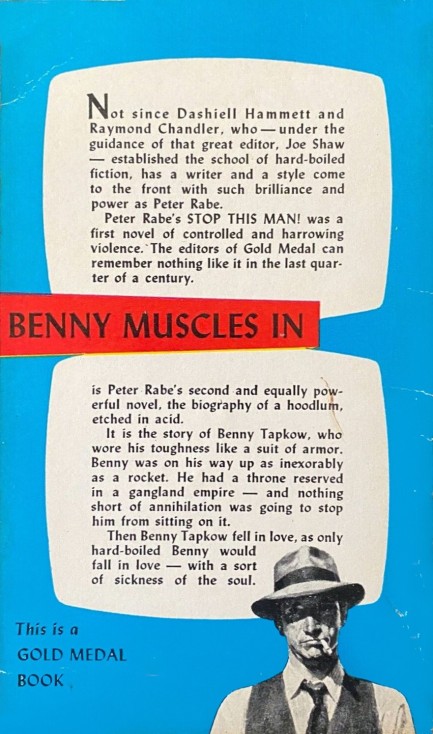
| Vintage Pulp | Feb 1 2023 |

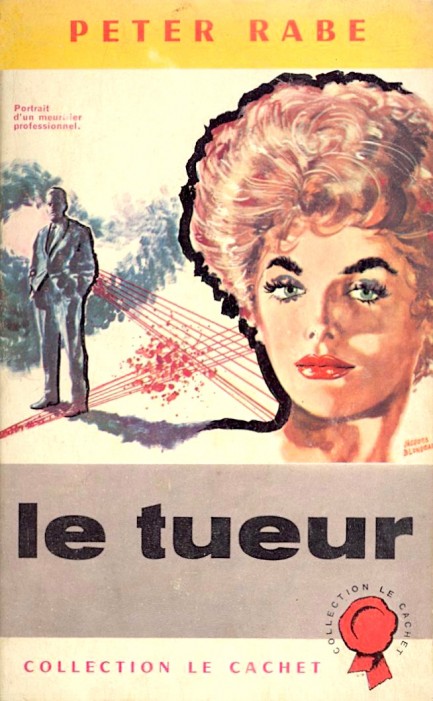
Above is a colorful cover for Peter Rabe's Le tueur, a book better known as Anatomy of a Killer. It was published as the latter in 1960, with this French translation from Éditions de la Trevisse appearing the next year. Obviously, there was a better known novel—actually a novela—by John. D. Voelker, aka Robert Traver, called Anatomy of a Murder that was published in 1958 and became an acclaimed Jimmy Stewart movie in 1959. Why did Rabe choose such a similar title? No idea. But the title tells the story: detailed examination of a professional hitman, as the narrative follows him from killing to killing. The art on this is by Jacques Blondeau, who painted numerous book covers during the 1960s. Based on this nice effort we'll stay alert for more of his work.
| Vintage Pulp | Nov 12 2020 |

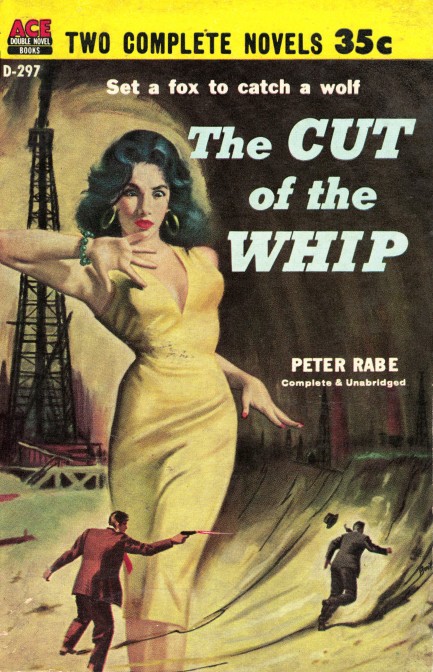
We're back into quasi-quarantine where we live, so what better way to use up double the idle time than with an Ace double novel? In The Cut of the Whip a loner named Dan Port fetches up in a dusty Texas oil town and finds bad luck and trouble when his sports car is rammed and totaled. The person who did it was fleeing town with a sheaf of valuable business documents. The owner of those dox—the fugitive's father—pays Port to retrieve them, and soon he finds himself the only person who can foil a kidnapping plot. The previous books we've read by Rabe verged on bizarre in terms of concept, but this outing is more conventional—we suppose because Port was a franchise character. Rabe would eventually wheel him out for six adventures. We missed the Rabe of efforts like The Box and Kill the Boss Good-by, but he's adequate here, if less imaginative. Port blows into town, whips the asses that need whipping, and drifts away to who-know's-where. Just like a franchise character should.
Robert H. Kelston's Kill One, Kill Two, like its partner book, starts with a deadly auto incident. Maybe that's why the novels were paired. But similarities vanish from that point forward. This book is set in Monterrey, Mexico, and opens with a bang when the protagonist runs over a man on a dark highway. Kelston uses this event to frame a set of circular relationships: there's the protagonist Allen McCoy, who is bedding Juanita, a local nude dancer widely considered to be the most beautiful woman in Monterrey, who is watched over by her hot-headed brother, and is lusted after by a knife fighter known as the Shadow, who's acquaintances with an alcoholic blonde temptress of easy virtue, who is having an affair with the dancer's husband, but all along is trying to bed studly Mr. McCoy.
We've given nothing away with that summary. Kelston shoehorns all that into the first thirty or so pages, and you might have to re-read them to keep the connections straight. Who was it that got run over, you're wondering? That would be Juanita's husband Raúl, the guy who's making naughty spoons with the blonde. Thus McCoy is perceived to have gotten a romantic rival out of the way, and is believed by local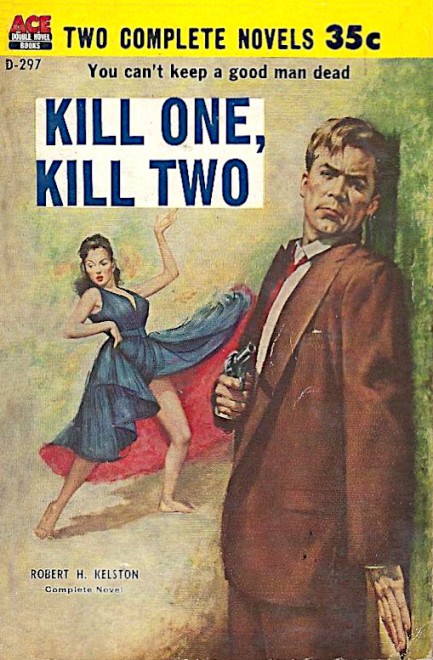 gossips to now be bedding both the dancer and the blonde. In local macho culture that makes him a pure stud, but for his corporate employers it makes him radioactive. The gossips have it all wrong, though. The death was an accident, a result of drunken driving and darkness. McCoy soon comes to believe that poor Raúl was thrown in front of his car, and must solve the mystery or see his career destroyed by the rumors.
gossips to now be bedding both the dancer and the blonde. In local macho culture that makes him a pure stud, but for his corporate employers it makes him radioactive. The gossips have it all wrong, though. The death was an accident, a result of drunken driving and darkness. McCoy soon comes to believe that poor Raúl was thrown in front of his car, and must solve the mystery or see his career destroyed by the rumors.
That's all fine, but the entire story turns out to be a fish too big for Kelston to land. He has it on the hook, then sees it wriggle off through pointless dialogue, confused motivations, and general lack of clear direction. We accepted the main character's motivation, but not necessarily his flimsy engineering background, nor his extraordinary bravery and physical competence in the face of danger. After all, he's just a builder. But that's genre fiction for you—on the page anyone can be a stud, even a pasty-ass, red-headed numbers cruncher like Allen McCoy. A cruel editor would have improved this tale, but in the end we enjoyed it anyway, because owing to our background we're predisposed to like adventures set in Latin America. The fact that it came packaged as an Ace double helped. We have a few other Ace doubles in the website, and you can see the whole lot by clicking its keywords below.
| Vintage Pulp | Nov 5 2019 |

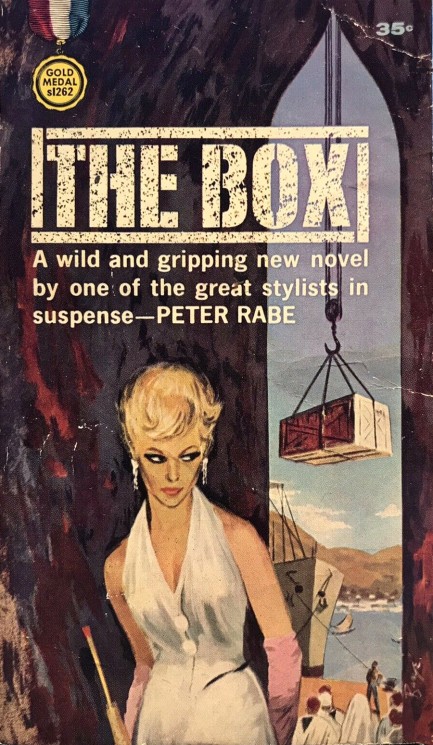
The book is okay. We liked the idea of Quinn continuing to live in a metaphorical box, even after he's escaped one physically. The thing about Rabe, though, here and in other efforts as well, is that he builds his story upon lots of verbal interplay and emotional subterfuge, filling the narrative with scenes of people never quite saying what they mean, and characters trying to understand the deeper implications of what they hear. It may confound some readers. Rabe is simply a very internal writer. We've compared him to Ernest Hemingway, which is easy to do considering Papa's vast influence, but in this case the similarities are particularly clear. The fact that the story is basically impossible to believe is almost disguised by Rabe's strong style. Almost. 1962 copyright on this, with art by Barye Phillips.
| Vintage Pulp | Mar 29 2019 |

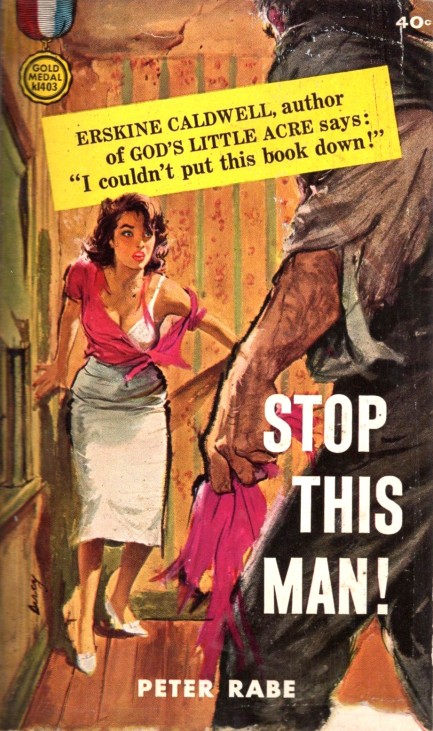
Catell is kind of radioactive too, actually, in the sense that he's bad news through and through. He plans to sell his killer treasure, but has no idea the radiation is turning it into mercury. It's a cool set-up for a thriller by Rabe in his debut novel. You may be thinking 1952's Kiss Me, Deadly did it first, but Spillane's novel does not have the radioactive suitcase made famous by the movie adaptation, so this could be—could be, because we haven't read every book out there—the first time this nuclear gimmick appeared. It was originally published in 1955, which means it's also possible the nuclear angle was influenced by Kiss Me Deadly the film, which appeared in May the same year. But while Stop This Man is cleverly set up and is as hard-boiled as any crime novel we've come across, overall we felt it should have been executed at a higher level.
| Vintage Pulp | Jul 26 2018 |

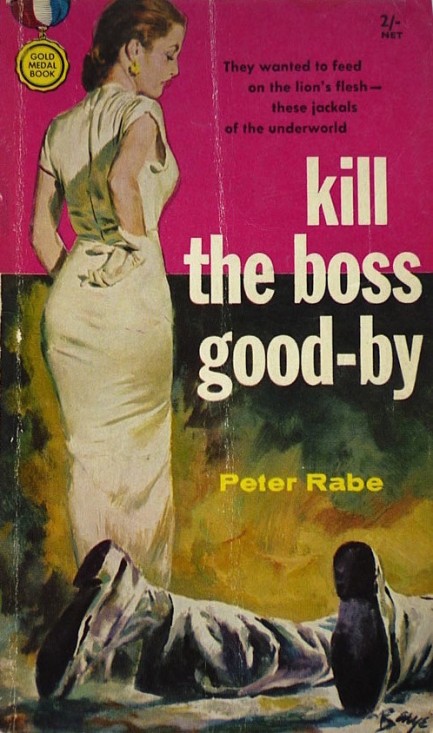
When the cat's away the mice will play, so the saying goes, and in Kill the Boss Good-By San Pietro crime kingpin Tom Fell goes missing for a month and a subordinate tries to take over his operation. When Fell reappears a power struggle ensues, while the top bosses in L.A. decide to wait and see who will come out on top. What makes the book a bit different is the reason Fell was missing—he was in a mental institution recovering from a breakdown with the aid of electroshock treatments. The new brain-scrambled Fell is calmer than the old Fell, but is he cured or is he worse? His enemies soon find out. Interesting hard boiled stuff from Peter Rabe, driven primarily by dialogue mixed with simple descriptive passages revealing a—dare we say it?—strong Hemingway influence. 1956 with cover art by Barye Phillips.
| Vintage Pulp | Jan 20 2015 |


Above, Murder Me for Nickels, 1960, by Peter Rabe, née Peter Rabinowitsch, for Fawcett Publications’ subsidiary imprint Gold Medal Books. The novel tells the story of a low-level organized crime flunkie named Jack St. Louis who works for a jukebox magnate. Because they control the boxes in their unspecified town and its environs they also control who scores a hit record, which brings not just money but a lot of wannabe starlets their way, some of whom Jack funnels through his side business—a recording studio. Unfortunately, Jack gets caught in a takeover gambit when mobsters from nearby Chicago try to strongarm his boss’s jukebox racket. Making matters worse is his boss’s available wife, who wants to be a singer. Well reviewed everywhere. The cover art is by Robert McGinnis.
| Vintage Pulp | Dec 27 2014 |


New Man in the House is the work of Peter Rabe writing as Marco Malaponte for Universal Publishing and Distributing Corporation’s Beacon Signal imprint, 1963. Ignore our sub-head, because actually it’s the fiftyish butler that does the seducing here, setting his sights on sixteen-year-old Lorna Hornaday. Yeah, how nuts is that? Her name is Hornaday. Oh, and maybe she’s a teeny bit too young, but the servant also hopes to butle his way into the more age-appropriate mother’s knickers, which suits him fine because she’s an ex-actress who still looks amazing. Classic sleaze, written under a pseudonym, because who’d really want to claim this? Uncredited cover art, too.




































































